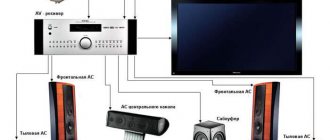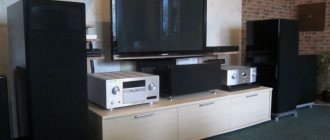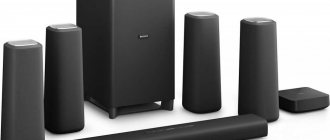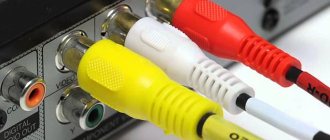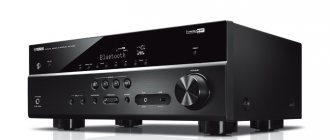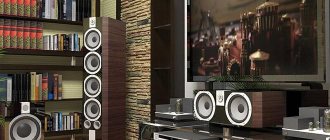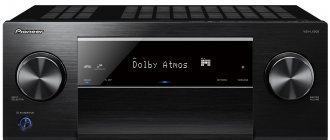The functionality of modern computers has no limits. And one of its possible options, in combination with a home theater, is the creation of a full-fledged multimedia center.
In this review, we will talk about ways to connect a home theater to a personal computer or laptop, give step-by-step instructions and analyze possible problems during pairing.
Watching home theater via computer
Why connect a home theater to a computer?
This connection solves one of two problems:
- Computer games receive higher-quality images and powerful sound, and it becomes possible to watch films and television programs taken from the Internet using a home theater.
- Temporary replacement of a failed TV - in this case, the video will be broadcast on a computer monitor.
A malfunction in the receiver or its absence can be solved by directly pairing the computer with the speaker system.
REFERENCE! The components of a home theater are a broadcast source (DVD player, satellite TV, etc.), a receiver (for converting and amplifying the signal), speaker systems (with or without a subwoofer) and a TV showing the image.
What cables are used for connection
High-quality surround sound from speakers directly depends on what cables are used for connection. Having understood the main types of connectors, all that remains is to choose the appropriate cable through which the devices will be connected.
HDMI ARC cable. Considered a high-definition interface, modern acoustics, such as sound panels and home theater, are connected to the plasma through it. The HDMI ARC cable is capable of transmitting truly high-quality surround sound.
HDMI ARC is available in three form factors:
- Full Size – for large equipment (TVs);
- Mini-HDMI – for smartphones, tablets;
- Micro-HDMI – for laptops, notebooks, and some tablets.
Cable with Scart-RCA interface. The “comb” and multi-colored “tulip” allow you to connect additional acoustics when the connection interfaces do not match on the connected devices.
Line out and headset jack. A common connection for stereo sound when the equipment has no other connectors. Additional speakers are connected via TRS or an L-shaped adapter 3.5 mm mini Jack - 2RCA.
Digital optical audio cable. It’s worth noting right away that the optical port is installed on the latest TV models; connection through this output provides the best multi-channel sound quality.
HDMI-RCA adapter cable (tulip). When connecting equipment with HDMI and RCA connectors, in addition to the possibility of a simple physical connection, you need to take into account technical nuances. The need to convert signals is most often achieved by choosing the right converter. So for a TV with an HDMI ARC port to speakers with an RCA connector (tulip) - an HDMI ARC to RCA/3.5 mm audio converter.
SCART-mini Jack adapter cable. A good solution for a subwoofer + TV when the LCD panel does not have a headphone input.
These are the main types of cables and adapters that are most often used to connect additional acoustics to any TV model.
Connecting a home theater to a computer via HDMI
Many modern people use this type of computer, such as a laptop, due to the fact that it is very convenient. This is a lightweight mobile device that you can take with you if necessary. At home, most users watch movies and play computer games on it. To get better sound, some of them connect 5.1 speakers. Connecting a modern laptop to your home theater is easy; you just need to follow a few simple steps.
Method 3. HDMI -> Multichannel Analog
The option using HDMI is more promising, since this interface is used much more often in modern gadgets.
To transmit a multi-channel audio track, the connector in the audio source must support the HDMI Arc protocol. Otherwise, the usual stereo signal will be broadcast, which will be converted into “virtual” 5.1 by software.
If HDMI supports this function, you can purchase such a converter. This box also supports pass-through transmission of a composite signal: by connecting a source via HDMI, you can separately output sound to an audio system via coaxial, optical or analog connectors, while running the video on a projector or TV.
How to connect
The easiest way to connect a laptop and a home theater system is via an HDMI cable. This interface is available on the player and laptop computer. An HDMI cable, as a rule, is not included in the cinema set. It needs to be purchased separately.
An HDMI cable is the best option that can be used when connecting your home theater system to various equipment. This is a multimedia interface that allows you to broadcast video and audio signals of the highest quality. HDMI is a universal connection cable that can be used to output both audio and video to a TV.
In this case, you need to connect the laptop and DVD player via HDMI. This is easy to do; you need to find a port with the appropriate designation on both devices. Next, you need to connect the acoustics to the player.
For this purpose, cords are used that are supplied with each cinema of this type. Communication occurs the same for all models. The instruction manual will tell you which wire and connector need to be connected in series.
The center speaker connects to the port labeled Center. The front ones must be connected to the connectors marked Front. Rear sound emitters are connected to sockets labeled Surround. The subwoofer connection port is labeled Subwoofer.
Before connecting the equipment, think about how best to place it in your room. The central and front speakers should be located near the sound source, the rear speakers should be in the corners of the room, preferably behind the user. The subwoofer can be placed in any convenient place.
A computer can replace many devices, be it a stereo system or a TV. But despite its ability to reproduce all known formats in a clear image, the machine cannot provide surround sound, helping to immerse the viewer in an exciting story. This problem can be easily solved if you know how to connect your home theater to your computer.
The lineup
Let's look at popular Samsung home theater models.
HT-J5530K
One of the most popular models from Samsung, which allows you to work with almost all devices and accepts most of the media existing today. Interfaces include Bluetooth. The power of the speakers is 165 W, the power of the subwoofer is about 170 W.
Users highlight the high quality of image and sound, ease of setup, functionality of the equipment and the presence of a pair of microphone outputs.
Among the minuses, we can note that it is not the easiest connection to the speakers, as well as an inconvenient remote control. In addition, the kit does not include a microphone and wires - you need to buy them yourself.
The plastic from which this equipment is assembled is not of the highest quality, which significantly reduces the period of use of the equipment. Prices in stores start from 20 thousand rubles.
HT-J4550K
This home theater kit includes 5.1 series speaker systems; interfaces include Bluetooth, USB, and Wi-Fi. Supports almost all formats and media. The front and rear speakers have a power of 80 W, the subwoofer power is 100 W.
The undoubted advantages of the equipment include the ability to read a wide variety of formats, as well as high quality audio and video. The home theater has a stylish and laconic design, and is distinguished by high build quality. For the most comfortable use, you can listen to music from your mobile phone via Bluetooth.
At the same time, this home theater has an inconvenient menu and a rather weak subwoofer, which does not allow you to listen to music in the highest quality. Connecting speakers is possible only through wires. The price tag in stores starts from 17 thousand rubles.
HT-J5550K
The package includes a 5.1 series speaker system. The interface includes USB, Wi-Fi, Internet, and Bluetooth. The main power parameters of the speakers correspond to 165 W, the subwoofer – 170 W.
The advantages of the technology include the optimal price-quality ratio, as well as the stylish modern design of the system. The cinema supports the versatility of its use.
At the same time, there are no wires needed to connect to the TV, and the connection cable is too short. In addition, some users note that when listening on low volume, unpleasant noises are heard from the speakers.
This is a rather expensive home theater, which costs more than 27 thousand rubles
HT-J4500
This is the best equipment that supports almost all existing media formats and media. The power of the rear and front speakers is 80 W, the same parameter for the subwoofer corresponds to 100 W. Bonuses are the presence of a radio, floor-standing acoustics and high-tech power supply.
Among the shortcomings are slight errors in the sound, as well as the lack of a karaoke option.
The price for the equipment is about 30 thousand rubles.
What you need to connect
Typically, users want to connect a 5.1 speaker system to a computer or laptop, since five speakers provide realistic surround sound. Modern computer games have a large set of sound special effects that make the gameplay very impressive. A stereo system can no longer convey all the nuances of such sound found in games and films. In this regard, acoustics with rear speakers are chosen as more relevant and powerful.
In order to connect a home theater to a laptop, you need:
- a device that reproduces an image (DVD player);
- acoustics set;
- connecting wires.
A disc player is necessary for the connection, as it will transmit the sound signal to the speakers and amplify it.
Automation is good, but hearing is better
Then you should play some well-known music or watch a movie clip. If the system sounds hollow or lacks something else, it is likely that the automated installation has suppressed some frequencies. To fix this, you need to find an equalizer or dynamic control setting. Sometimes it has its own name, such as Audessey or Dolby, but regardless of the name, you just need to turn it off and the sound should improve.
Subwoofers may have their own volume and frequency controls, called crossovers. If they were purchased with the system, then all this should be controlled by the on-screen menu. Otherwise, the subwoofer will have to be configured separately.
When connecting home theaters, you should always start with the suggested settings and change them only when you are confident that the problem can be solved by simply moving the speakers. Sometimes even a few centimeters make a difference.
Sound amplifier for PC
To make the sound of movies you watch on your computer more spacious, you can connect a DVD player and speakers to the machine. To do this, you need a cable with tulips at one end and a minijack at the other; as a rule, it comes with the cinema.
Step-by-step connection instructions:
- Insert tulips into the player's IN socket.
- Insert the minijack into the free slot for the sound card into the PC system unit.
- After connecting, go to the sound card setup menu.
- In the sound settings, note that 6 speakers are now used.
After scanning is completed, you can enjoy high-quality sound through your speakers. Now the sound waves will be correctly distributed to each speaker, creating surround sound in the room.
This method is quite easy and allows you to watch online movies and play games with high-quality sound. In this case, nothing changes fundamentally, and the recreation center acts only as a sound amplifier. Of course, you don’t need to buy new equipment specifically for this method, but you can use an old player that has not been used for a long time.
DVD player
The most convenient way to eliminate all misunderstandings is to use an amplifier. It can be used to connect all devices. Any DVD player is perfect for this role:
- Take a cable that has “tulip” connectors on one side and the most common 3.5 mm minijack on the other side.
- The player simply connects to the output of the computer's audio card, namely, the output that is responsible for connecting to the speakers.
Important! This input is usually indicated in green, and in some cases it will be labeled with the word “out”, which means “exit”.
- The output of the “tulips” must be connected to the sockets of the DVD player.
Important! The pin itself is indicated in red and white with the mark “in”. Most often, the above cable should be included with your home theater system, but if it is not available, you can always buy it cheaply at electronics stores.
We connect the speakers and subwoofer to the “amplifier”
Now we have come to the second stage of connection - connecting the speaker system to an amplification device. For this we need the cables included in the kit. Using them, we connect all the acoustics to the player, matching all the inputs and sockets. You are unlikely to get confused, since each entrance is marked differently.
Read also: How to hold a hammer correctly
How to connect speakers from a home theater to a laptop? We are almost at the answer to this question. Let's move on to setting up the equipment.
Settings
The next stage is setting up the equipment. For this:
In the Windows operating system, you need to go to the menu with the settings of your sound card. This menu is located in the Start panel. You need to go to the section where there are controls for all audio outputs and inputs. There you need to indicate that six columns will be used.
Important! The program will automatically adjust the sound of the acoustics. Now all that remains is to launch the player, select the desired audio input channel and enjoy the clear sound that will now always be on your computer.
Home theater via PC monitor
This method is suitable if your TV or projector breaks down, since watching movies on a small computer monitor is not very comfortable. The connection can be made in two ways:
- HDMI cable;
- VGA cable with tulips at the end.
In the first case, you can easily switch from a PC monitor to a TV and watch the image where it is convenient. The second option is suitable for older devices that do not support HDMI. Both connection options are ideal for online computer games, since the dynamics of the picture are constantly changing, and not all TVs are able to quickly respond to changing images.
What to do if there is no sound after connecting your home theater to your PC
If after connecting there is no sound on the PC, you should try restarting the OS and checking the operation of the equipment. The operating system may not have automatically identified the new hardware as the default.
In the task area, using RMB, click on the speaker icon and select “Playback devices”. In the list that opens, highlight the hardware type (5.1) and click the “Default” button. Use "Apply" and "OK" to save the configuration.
REFERENCE! In the same window, by pressing the “Properties” button, you can further configure the operating parameters by switching between tabs (balance, effects, etc.).
Another reason for the lack of sound may be the lack of setting the required channel on the player. Go to the amplifier menu and activate the audio channels used. This can be done by selection.
Conflicts between different devices are possible when all components are used: speakers, TV, receiver. To resolve the issue, it is necessary to separate the video and audio signals. For this:
- We connect the receiver to the TV via an optical cable (the problem with sound is eliminated).
- We connect the TV and PC with an HDMI cable.
We examined in detail the methods of connecting a computer and a home theater. We hope that the article answered all readers’ questions on this topic.
What to do if there is no sound?
Many people are concerned about the problem of sound output when connecting a home theater to a TV. It's all about the complexity of the connection: the cinema is connected to a PC, but the TV is used as the image output, not a computer monitor. That is, 3 devices are involved in the process at the same time, which can cause various conflicts.
One of these is the situation when the sound is played from the speakers built into the TV, and the 5.1 speaker system is completely ignored by the player (changing the audio settings also has no effect). The matter may be hidden in the discrepancy between device models from different manufacturers.
However, this problem can also be fixed, although you will have to buy something extra:
- the TV and home theater are connected by an optical cable (the problem with sound is solved);
- The TV and computer are connected with an HDMI cable (the sound is still ok, but the image quality has become better).
Thanks to this scheme, audio and video signals are separated, after which they no longer conflict with each other. As a result, the sound comes from 5.1 acoustics, and the image is supplied to the TV from the computer.
There are still a considerable number of different difficulties that may arise, but these are individual situations. In general, if you properly configure and connect your home theater to your computer, major problems can be avoided. In all other situations, there will most likely be a serious technical malfunction.
Types of connectors
Before connecting, you need to decide which ports are on the two devices. This is done in order to select the desired wire to connect the speaker system and laptop PC.
- HDMI is a connector that looks similar to a USB port, but is longer and thinner. Transmits video and audio data in one cable. Provides a digital signal with minimal setup effort.
- VGA resembles a rectangle with rounded corners. The connector consists of 15 contacts (5 contacts in 3 rows), provides transmission of an analog video signal. To transmit sound, an additional cable is required to connect the headphone jack to the speakers or cinema system.
- RCA. Sometimes you can find a composite video connector (usually yellow) in laptops. To transmit an audio signal, use the headphone jack via “Mini-Jack” - “RCA”.
Options for connecting a home theater to a computer
Connecting a home theater to a computer can be done in two ways. In the first case, the PC is connected to a DVD player with connected speakers to output the audio track, and to the TV via HDMI to transmit the image. In the second case, the acoustics are connected directly to the computer.
Computer, TV and speakers
To connect a home theater to a computer for audio output, you will need a receiver, which is usually a DVD or Blu-Ray player. This device receives the entire sound range, and then divides it into components and sends a fragment corresponding to its intended purpose to each connected speaker.
As a result, if the sound according to the events of the film is heard from behind, then the viewer will hear it from the rear speakers. Different speakers are designed to deliver different audio tracks, so, for example, the voice will be heard from the center speaker above the TV, rather than from behind or to the side. This creates the feeling that people are talking on the screen. First you need to connect the speakers to the receiver. For this purpose, the cable that comes with the speakers is most often used.
The connectors on the player are usually marked accordingly, so it is almost impossible to make a mistake and connect a subwoofer to the output for the center speaker.
The output marked Front R and L is used to connect front speakers, Center - central, Rear or Surround - rear, Subwoofer - subwoofer.
The next step is to connect the player to the computer. You will need to purchase, if not included, a 2RCA cable (tulip-type plugs in red and white) - mini Jack 3.5 mm (headphone jack).
This wire is connected with a 3.5 mm plug to the green output marked OUT on the computer audio card, used to output sound to headphones or stereo speakers. “Tulips” are connected to the receiver into the red and white inputs marked IN. Now you need to connect your TV or monitor to your home theater. For this, types of cables such as VGA, HDMI, DVI are used. The second and third types of wire are more preferable, because transmit images in the highest possible quality.
In addition, DVI and HDMI also broadcast an audio signal, so the sound when watching a movie can simply be transmitted to the TV speakers, without using a home theater. If your computer and TV set do not have the same connectors, you can use adapters, for example, DVI-HDMI.
To establish a connection between the equipment, you need to connect both switched off devices with a cable, then start them and on the TV, in the list of signal sources, select the input to which the computer is connected. If there are several of them, the markings that are usually present near the connectors on the back or side panels of the television receiver will help you avoid mistakes. When connected with HDMI and DVI cables, the audio signal is output directly to the TV.
To transfer it to a home theater, you can connect an optical cable or HDMI input on the receiver and output on the TV set. Another option is to connect the TV and speakers connected to the player with a 2RCA-2RCA or 2RCA-mini Jack 3.5 mm cable. If there is no sound when connecting via HDMI, you should make sure that both devices support the ARC standard, which allows you to transfer the audio track from your TV to your home theater. Thus, when connected through the player on the computer, the movie starts. The image is displayed on the TV, and the sound is output through the receiver to the home theater speakers.
Direct speaker connection
If the user purchased an advanced 5.1 sound card for the computer with a number of additional channels, it is not necessary to use an AV receiver for connection. All you need is to purchase several 2RCA-mini Jack 3.5 mm adapters.
Next, the front speakers are connected to the green connector on the audio card via an adapter, the rear speakers to the black connector, and the center and subwoofer to the orange connector. To connect side speakers for 7.1 systems, the gray output is used.
Connecting using an HDMI connection
After selecting the desired wire, to connect the devices, connect them with a cable, making simple settings.
Connection procedure:
- Turn off your devices.
- Connect one end of the wire to the HDMI input port on your personal theater receiver, and the other end to the HDMI output port on your laptop.
- Turn on the equipment.
- In the speaker system settings, select the desired jack and set it as the signal source.
- To configure your PC, right-click on the screen and select the “Screen Resolution” option from the drop-down list. Set one of the commands: expand the image to both displays, turn on one of the screens, duplicate the video image.
If the monitor is on a high-definition home theater (HDTV), then the video can only be seen on the TV screen, and not on the laptop display. To see elements on your laptop monitor, turn off your personal cinema.
If this jack is not available, use an adapter that can be used to connect the HDMI connector of the speaker system to the USB port of your laptop. However, this will result in loss of image quality.
Connecting devices via HDMI is the most preferable option, as it provides the most optimal quality of audio and image transmission.
Via local network
The home theater can be connected via a local network. This way, the computer will play and send signals to the speaker system, but you can use it as you wish.
The media center will play the movie from the computer (the video files must be located in a separate shared folder), the home theater will also receive audio signals from the PC, but the computer can be used as desired at this point.
The only disadvantage of this connection scheme is that the selected home theater requires a TV or monitor, since the computer will not broadcast the video image on its own. This is due to the nature of the connection: the media center only receives information from the computer, but is unable to force it to turn on the video.
The sequence of actions for a local connection is quite simple:
- the home theater adapter is configured to receive a signal from a Wi-Fi router; if it is not available, this can be done via a LAN/network cable;
- enter the password for the Wi-Fi network (not required for a wired connection);
- run any video as a test.
Thanks to this connection, it becomes possible to watch movies located on the computer’s hard drive, for example, downloaded from the Internet. But even this is not necessary, because by slightly customizing the functions of the media center, you can receive the signal online (broadcast a movie directly from the Internet, while the computer will act as a connecting link).
Additionally, it becomes possible to use unique functions such as karaoke.
The main disadvantage of this type of connection is the need to have a TV or monitor specially connected to the cinema’s media center.
Review. Krell Vanguard Universal DAC. The most versatile DAC
Not so long ago, the difference between a network player and a DAC was quite obvious - the player immediately provided you with an analog output, and you could connect it to your local network on the one hand, and to an amplifier on the other. The DAC required a separate digital source, but provided extensive switching capabilities.
In both cases, we had some compromise, but at the same time we had no idea what the solution would be. And not so long ago, devices began to appear that could not be called either a player or a DAC, in the strict sense of the word. Progress in the miniaturization of digital sources and their transfer to the ARM platform has made it possible to place this module directly in the DAC housing without sacrificing the switching capabilities of the latter.
Today I’m testing just one of these devices – the Krell Vanguard Universal DAC. And the key word in the name of this DAC is Universal, that is, “universal”. And this is truly one of the most versatile devices I have ever seen.
Promoted
Computer monitor instead of TV
This type of connection most often helps in case of a TV breakdown or general malfunction. In general, this can help in other circumstances, but it is not possible to list all of them.
The bottom line is that the PC monitor will be used to play the image, while everything else works from the home theater.
This method is also used by video game fans, only in the opposite direction: they transfer the image from a computer monitor to a large screen. In both cases the connection will be identical.
To connect devices together you can use:
- HDMI cable;
- VGA cable, with or without a tulip.
If the owner has a modern computer and the same home theater, then most likely there are HDMI connectors. You should connect through it, since this data transfer format is the best of its kind (for both video and audio).
For older computers and/or theater media centers, use a VGA cable. It was through it that devices were connected before the advent of HDMI. But this cable must have a “tulip” at the opposite end if the media center does not have a VGA connector.
A “tulip” is a cable branching into three plugs with different colors. Most often these are red, white and yellow, but there may be others (for example, COMPONENTVIDEO with red, blue and green colors).
This connection method has no particular advantages or disadvantages. Often, this is a last resort in controversial situations (the same TV breakdown, etc.). On the other hand, a computer monitor has a much lower response, and new frames will appear earlier than on a TV screen. That is, the scenes will become more dynamic, although modern television models have long been not inferior in functionality to computer monitors.
Why is this even needed?
Home theaters allow you to feel the effect of presence.
The main functions of such a technical system from a computer and a home theater are as follows:
- the ability to watch films and programs directly online;
- enhancing the immersion effect in virtual reality during games;
- karaoke connection.
Sound amplifier for PC
A home theater speaker system can be used as a sound amplifier when working at a computer: watching movies, playing games, listening to music. However, you cannot simply connect the speakers to the system unit - nothing good will come of this, since a receiver is required.
It will be a regular DVD player. Its presence is necessary because it takes in the entire sound, and then breaks it into parts, sending the required audio fragment to each specific speaker.
Thus, the entire acoustic system will be used, and if the sound in the film comes from the right, then it will sound from the right speaker. If you connect the acoustics from the home theater directly, then either the sound card on the computer will burn out, or the speakers will be damaged (the sound will be so strong that the acoustics will not withstand the voltage).
The connection procedure should be carried out correctly, using a mini-jack “tulip” cable:
- The Mini-Jack plug is inserted into the corresponding connector on the PC system unit (marked in green, headphones are also connected there);
- the red and white plugs on the "tulip" will connect to the DVD player marked "In" in the corresponding colors on the panel;
- The cinema speakers should be connected to the player using the supplied cable (or a set of them), all connectors are marked, but to be sure, you can use the instructions from the home cinema;
- on your computer you should go to the settings of the sound card (indicated as “Sound inputs/outputs”) and change the type from 2.0 to 5.1 (this is the 6 speakers of the speaker system);
- On the DVD player, you also need to change the audio input channel so that the sound is correctly transferred to the speakers;
- in case of an error, the sound will not be played in principle, so you can safely experiment;
- After all the settings, any audio track (music, movie, game) is turned on and the quality and presence of sound is checked.
If the sound from the speaker system comes with interference that was not there before, or in other speakers, it means that there was an error in connecting the cables, or the speaker has become unusable.
User Misconceptions:
Misconception #1. When you are finished playing you should switch everything back for correct operation. If you keep one of the on-the-fly encoding technologies always on, you will not be able to view and listen to files with multi-channel audio, since they are already encoded and require output directly to S/PDIF.
Solution: you don’t need to switch anything, watch a movie in stereo - it’s laid out at 5.1, watch a video with a DTS or Dolby track - the sound is perfectly laid out across channels. This can be seen even on a player that can switch audio tracks, for example, The KMPlayer.
Misconception No. 2. On-the-fly encoding of stereo sound from an mp3 file using Dolby Digital Live or DTS Connect will be several times inferior to hardware decomposition of such sound on speakers or a receiver.
Solution: If acoustics of similar quality are connected to the receiver, the difference will not be so significant. The main thing in the settings of THX Studio Pro (or a similar “improver” of the sound card) is not to forget to disable the options that create various effects: for example, it makes the voice stand out from the general sound background. Much depends on the sound card; Creative Titanium HD copes with this with a bang.
Via mini-jack adapter
In addition to the above 3 connection options, you can purchase special adapters. One of them is a Mini-jack adapter with sockets for acoustics. Thus, you can not use a DVD player, but connect the speaker system directly to the computer.
However, the built-in sound card will not be enough. It is necessary to purchase a more advanced model that will be able to work with 5.1 type acoustics.
Sound settings
After connecting the speaker system to the computer, you will need to perform simple setup. It is necessary to indicate in the PC settings that for sound reproduction it is not a stereo system that is used, but 5.1 acoustics.
To do this, you can use standard Windows tools or programs installed when installing drivers on the sound card. In most cases, this is the Realtek manager, but there are other applications. You can find the icon in the tray at the bottom right of the screen or in the Control Panel.
You need to open the section in which you manage audio inputs and outputs and indicate that the audio signal is now broadcast not to two, but to 6 speakers. Next, if the connection was made through the receiver, you need to open its settings and indicate through which audio input the sound signal is received. To check how the connection works, you need to start a movie or music on your computer. If everything is done correctly, sound will be heard from the home theater speakers. Next, all that remains is to adjust its quality using the equalizer. You can also adjust the location of the acoustics, try moving them around the room, raising or lowering them to achieve the perfect sound.
Conclusion To hear the best quality sound while watching a movie or playing music, you need to know how to connect your home theater speakers to your computer. This can be done in several ways: through a DVD or Blu-Ray player, or directly to the sound card.
Sometimes this requires purchasing one or more additional cables. After the equipment is connected by cable, you need to perform a simple setup. Now high-quality surround sound will be played through the speaker system.
We combine all options
Many home theaters allow you to connect your computer in more than one way, but sometimes in all ways at once. This allows you not to think about choosing a connection option: feel free to use all possible ones. A nuance: the connection will only make sense if the PC and TV are in the same room and preferably next to each other, then the placement of the speakers will be correct. However, if your video system allows you to connect to a local network, then there will simply be no need to connect it as an amplifier.
Good afternoon, dear forum users. I encountered a problem with outputting sound from a PC to a recreation center. After reading a lot of manuals and various tips on the Internet, I realized that I couldn’t achieve real 5.1. But my problem is that when connected, only two front speakers work. How to get all 6 channels working? And so - availability: 1. Home cinema: LG-HTK806TH connectors on the DC 2. sound on the PC - integrated, mat. board: Asus M4N68T-M LE V2 3. “Tulip” - jack 3.5: Photo
My actions: I connected the tulip to the recreation center, Jack 3.5 to the sound card in the sound settings and set it to 5.1 photo. I reinstalled the latest drivers for the motherboard and also set everything to 5.1 photo
But nothing at all, I turn on music, HD 6 channel movies - the effect is the same, only 2 front speakers work.
Thank you for your attention.
How to connect a home theater to a computer 5.1 Home theater Sony DAV-FZ900M (https://nadavi.ru/descr/sony/dav-fz900m/descr-40.php).
How to connect a home theater to a computer? Actually, the question in the topic is there is a cinema and a computer, how to connect it so that 5.1 sound comes from.
How to connect a home theater to a computer Hello everyone! I have a similar question for you. There is an Elenberg HT-111 home theater.
How to connect a home theater (Panasonic SA-HT880) to a PC? Greetings, forum members. You can throw stones at me for raising a topic that is for sure.
I can’t connect a home theater to a PC. I have a PC with an Asus motherboard with an optical output, and a 5.1 Samsung HT-TZ325 system -.
Using a computer, users watch movies, listen to music, and complete the next level in the game. In this case, special attention is paid to sound quality. Knowing how to connect a home theater to a computer, you can achieve highly realistic reproduction.
How to setup?
After synchronization is completed, you need to perform a simple setup for the equipment to work correctly. In the operating parameters of the PC, you should specify the new playback equipment, choosing acoustics with a 5.1 configuration instead of the previous stereo system. As a rule, Realtek manager is used to configure audio equipment.
You can also use other programs. In some cases, configuration can be done through the Windows operating system.
There is a speaker icon on the taskbar in the lower right corner. Right-click on it and in the menu that opens, find the item responsible for playback devices. Open a window and on the first tab, among the list of devices, select the one you want to use. By right-clicking on the name of the speaker system, you will see that the computer will offer to turn on/off the equipment, as well as make settings. In the setup menu, the user can check the sound reproduction through the new speakers and subwoofer.
After completing the operation, you need to click on the “Ok” button and then “Apply”. If everything is done correctly, the audio signal will be broadcast through your home theater. To adjust the sound quality, you can use an equalizer. The placement of the speakers also affects the sound. Try moving some of them or expanding them.
Driver Need
To operate a sound card, a special program called a driver is installed on the computer. With its help, laughter understands user commands and recognizes connected devices. If, when you connect new music equipment, the signal does not come through the speakers, the problem may be due to an outdated driver or a missing one.
After reinstalling the operating system, the driver must be installed again. When purchasing a sound card, a disk with the program must be included, or the manufacturers indicate a link from which it can be downloaded. The driver needs to be updated periodically. If the software has not been updated for a long time, it is recommended to completely remove it and install it again. Each version of the sound card uses its own version of the driver.
You will learn how to connect a home theater to a computer in the following video.
Using an HDMI cable
There is another way to “pump up” your personal computer - using an HDMI cable. Here the TV will act as an amplification device, to which all the sound is connected. The computer itself needs to be connected to the TV using a digital HDMI cable, which can be easily found and purchased at any hardware store.
Important! There is only one point - before the purchase itself, you need to evaluate the distance that separates your PC and TV, and select the appropriate cable length. If you connect these two devices, your TV will turn into a large monitor through which you can always view and listen to media files in high quality “Dolby Digital”.
How to connect speakers from a home theater to a computer in another way? Everything is very simple! Read on.

